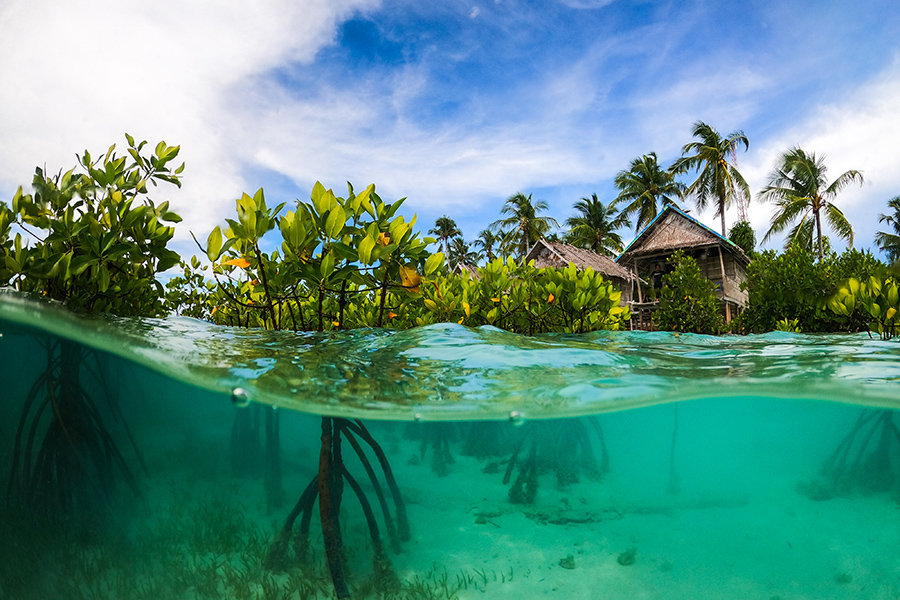Mangroves play an important role in sequestering planet-heating carbon dioxide emissions, but they are disappearing fast in Indonesia. In a rural office on Bengkalis island, off the northeast coast of Sumatra, 30-year-old Mayasari runs a face mask dyed with tree sap through an antique sewing machine.
The day before, Mayasari, who goes by one name, and a dozen other women in Pedekik village, learned to make hand sanitizer with an extract from the mangrove trees that fringe the coast. “Alhamdulillah (praise be to God) — if this comes from nature in Bengkalis, then it’s great,” says Mayasari.
The Bengkalis training is the first government program addressing the double hit from coronavirus and climate change among mangrove-dwelling communities in Indonesia. The face masks made by the Pedekik women’s group are sold for 2,000 rupiah ($0.14) each, offering a new source of income for members.
Besides this scheme in Riau province, others are also underway in South Sumatra and South Kalimantan, demonstrating to communities the practical value of keeping their mangroves standing. Indonesia — the world’s largest archipelagic country and the biggest home of wetland forests — counts about 3.3 million hectares of mangroves across its rivers, basins, and shorelines, an area larger than Belgium.
These mangrove ecosystems provide vital services to local communities, from food to protection against storm surges. Mangroves also store one-third of the world’s coastal carbon stock and about five times as much per hectare as Indonesia’s upland forests.
But according to a 2015 study from the Center for International Forestry Research (CIFOR), about 40% of Indonesia’s mangroves were lost in the previous three decades. They are often ripped out to make way for shrimp ponds and other small businesses like charcoal production, which provide economic security for millions but account for most mangrove loss.
Last year, President Joko Widodo expanded the remit of Indonesia’s peatland restoration agency to include ambitious plans to restore 600,000 hectares of damaged mangrove forests by 2024.
About 90% of the budget allocated this year to Indonesia’s Peatland and Mangrove Restoration Agency (BRGM) was for planting seedlings, but a small amount was earmarked to foster change in how communities view mangrove forests.
Mayasari first learned to weave local batik and tenun textiles at age nine. Today, she makes 13 feet of traditional fabric every few weeks, earning about $150 a month. But as a single parent with two children to put through school, she makes only a small profit because she must buy expensive and unhealthy chemical dyes. This year, the mangrove agency began working with Achmad Nur Hasim, an Indonesian designer who has supplied tenun fabric to French fashion brand Christian Dior.
Achmad says 90% of traditional textiles in Sumatra are dyed using synthetic products. He hopes textile weavers in Pedekik and elsewhere will instead adopt natural dyes derived from the sap and fruit of local trees, supporting broader efforts to conserve mangroves. Just outside her home, Mayasari says she can find the jengkol tree used for darker shades, pinang for orange, and bixa for red. The Bengkalis women’s group recently won a public vote for the best collection of handwoven clothes at the TENUN Fashion Week in Malaysia, which showcased work by 45 women’s weaving communities across Southeast Asia.
One key reason to stop further destruction of Indonesia’s mangroves is to ensure the climate-heating carbon they store remains in their biomass and the soil they grow in. Research shows global warming also hikes risks to mangrove ecosystems. A 2016 study published in the journal Wetlands Ecology and Management indicated coastal mangroves in Indonesia and elsewhere could face inundation from rising sea levels within 35 years without stronger action to curb climate change.
Promoting mangroves as the source of natural clothing dye is just one way communities can treat these valuable trees as a resource to nurture, which can hold back rising tides and become a new source of income for impoverished communities.
Harry Jacques is a contributing writer to the Thomson Reuters Foundation, based in Indonesia.




































